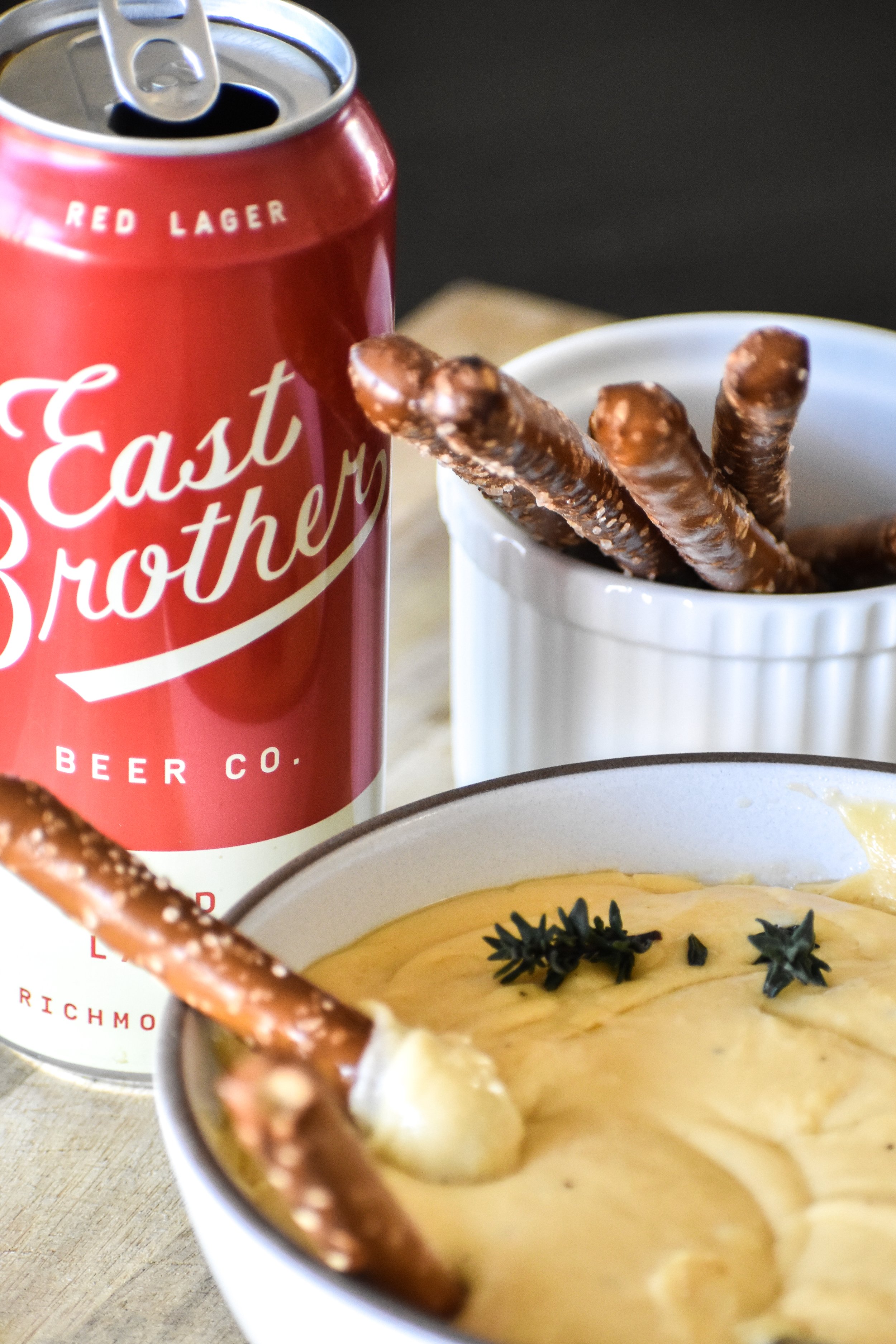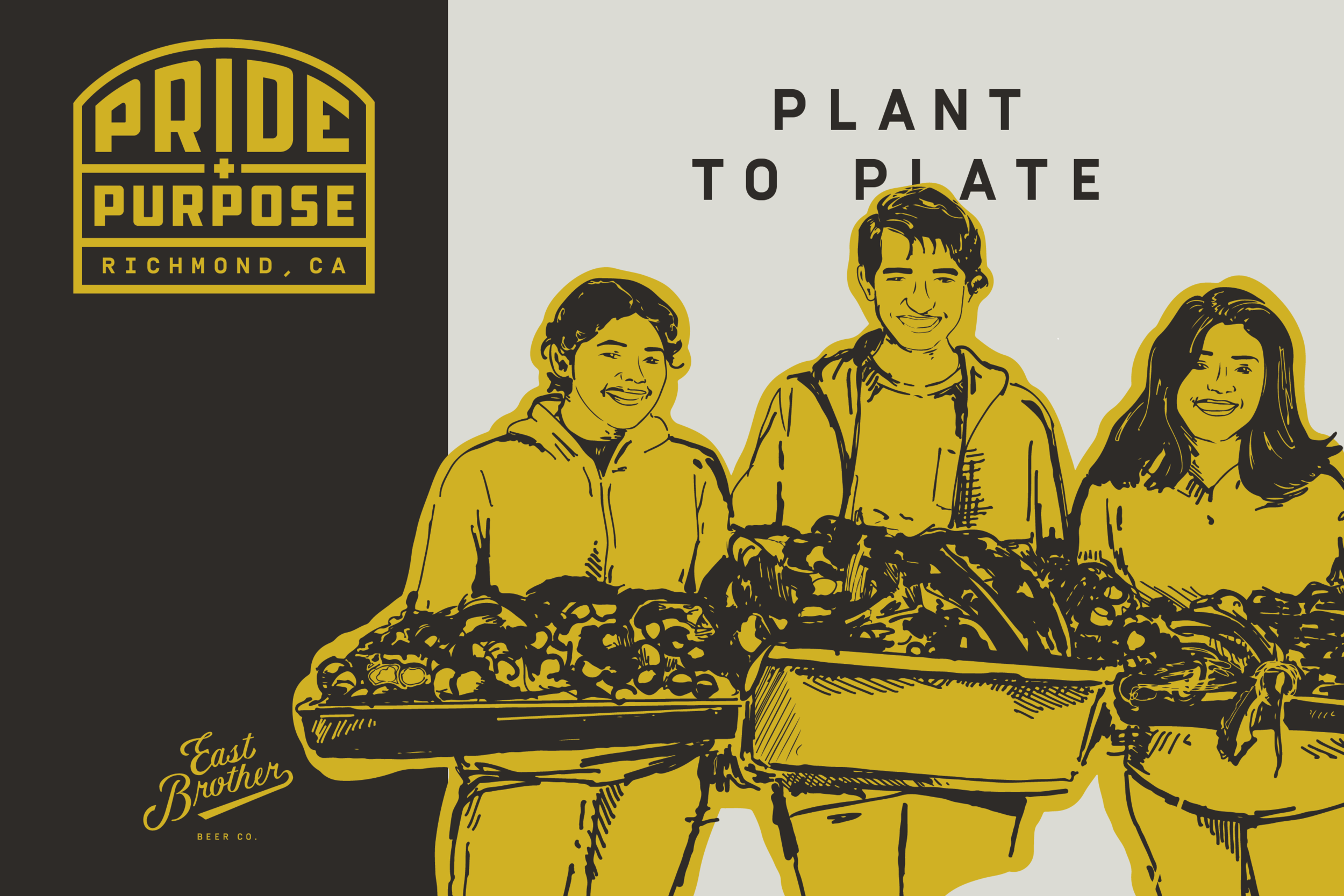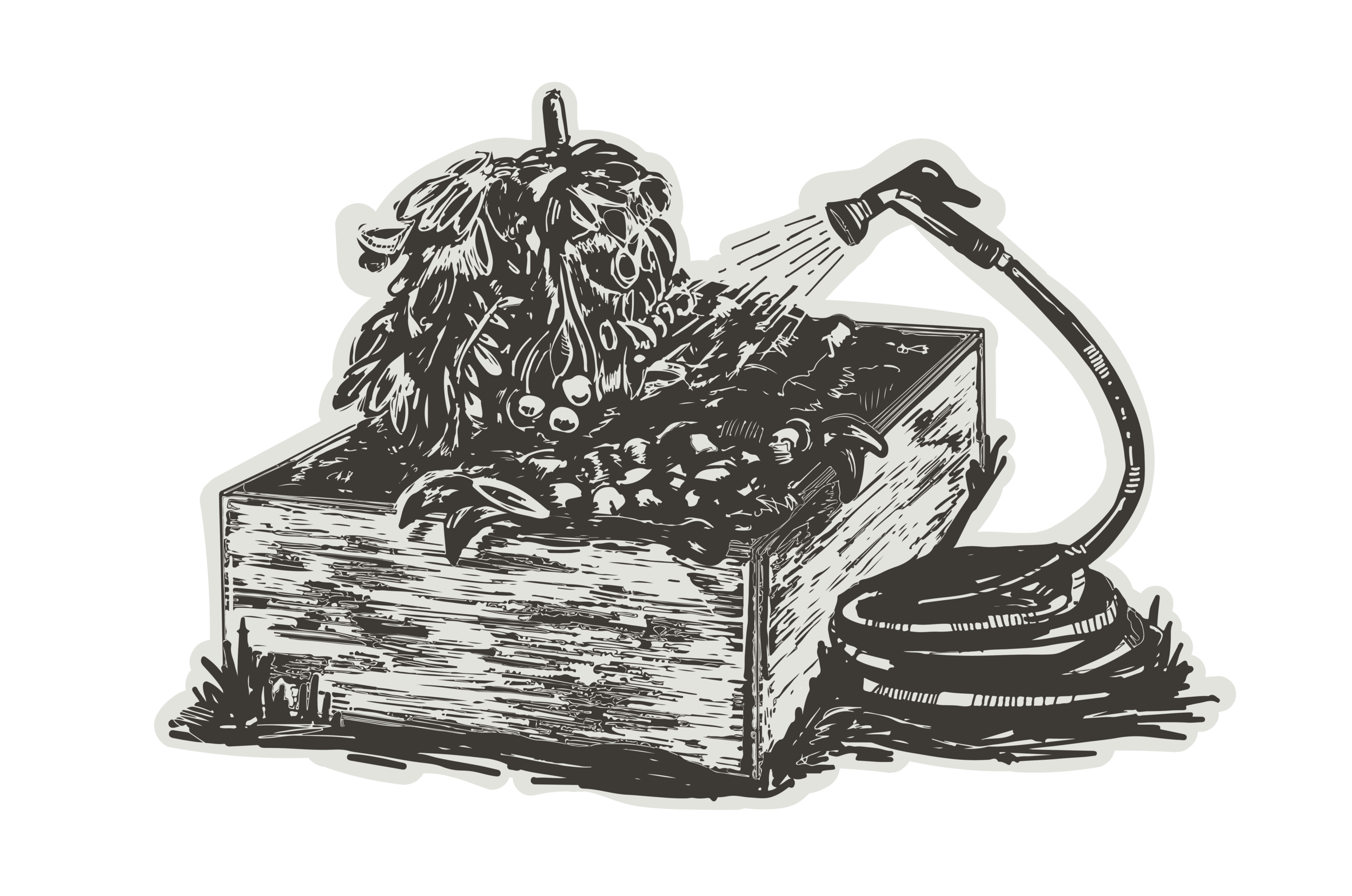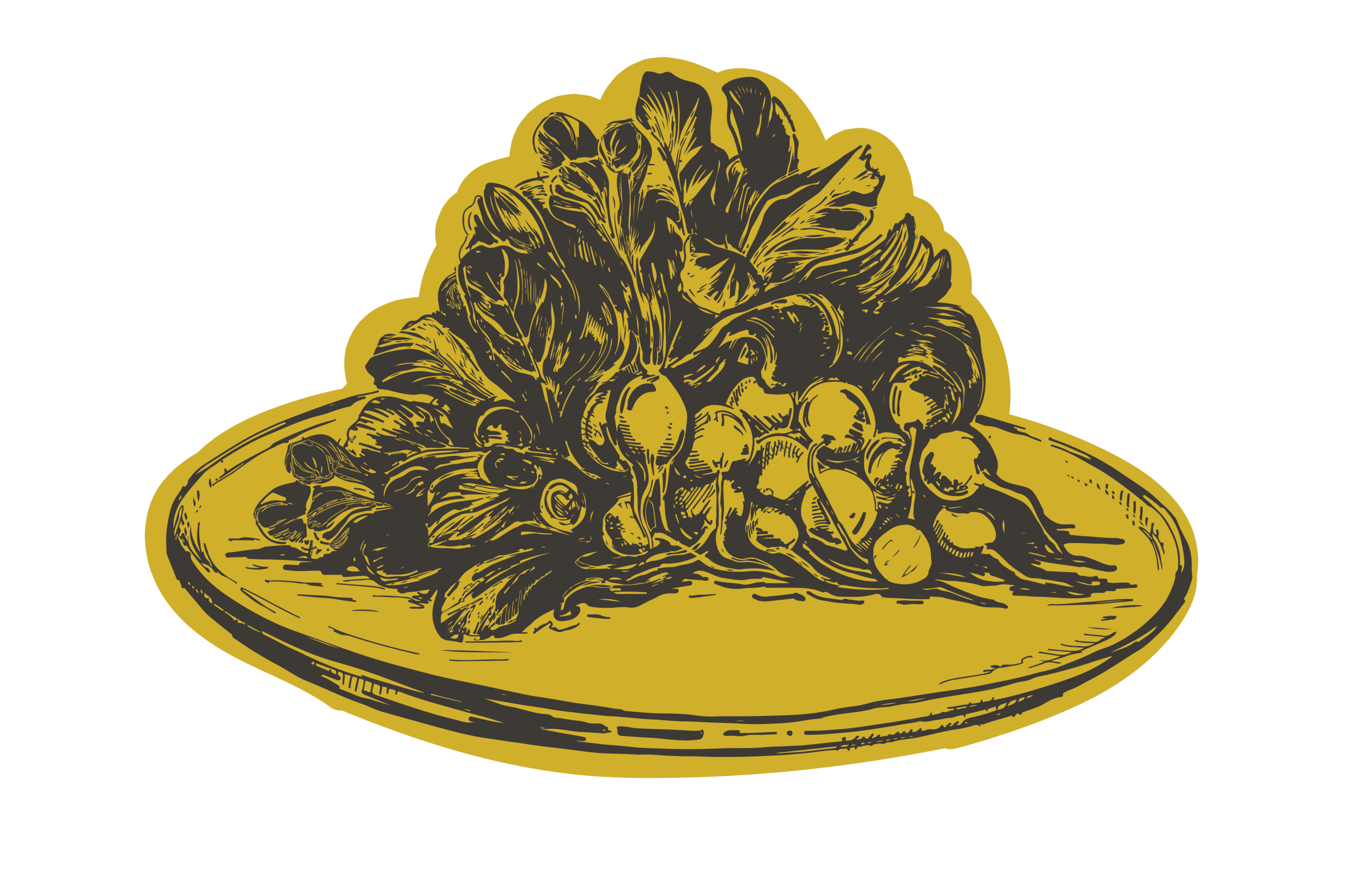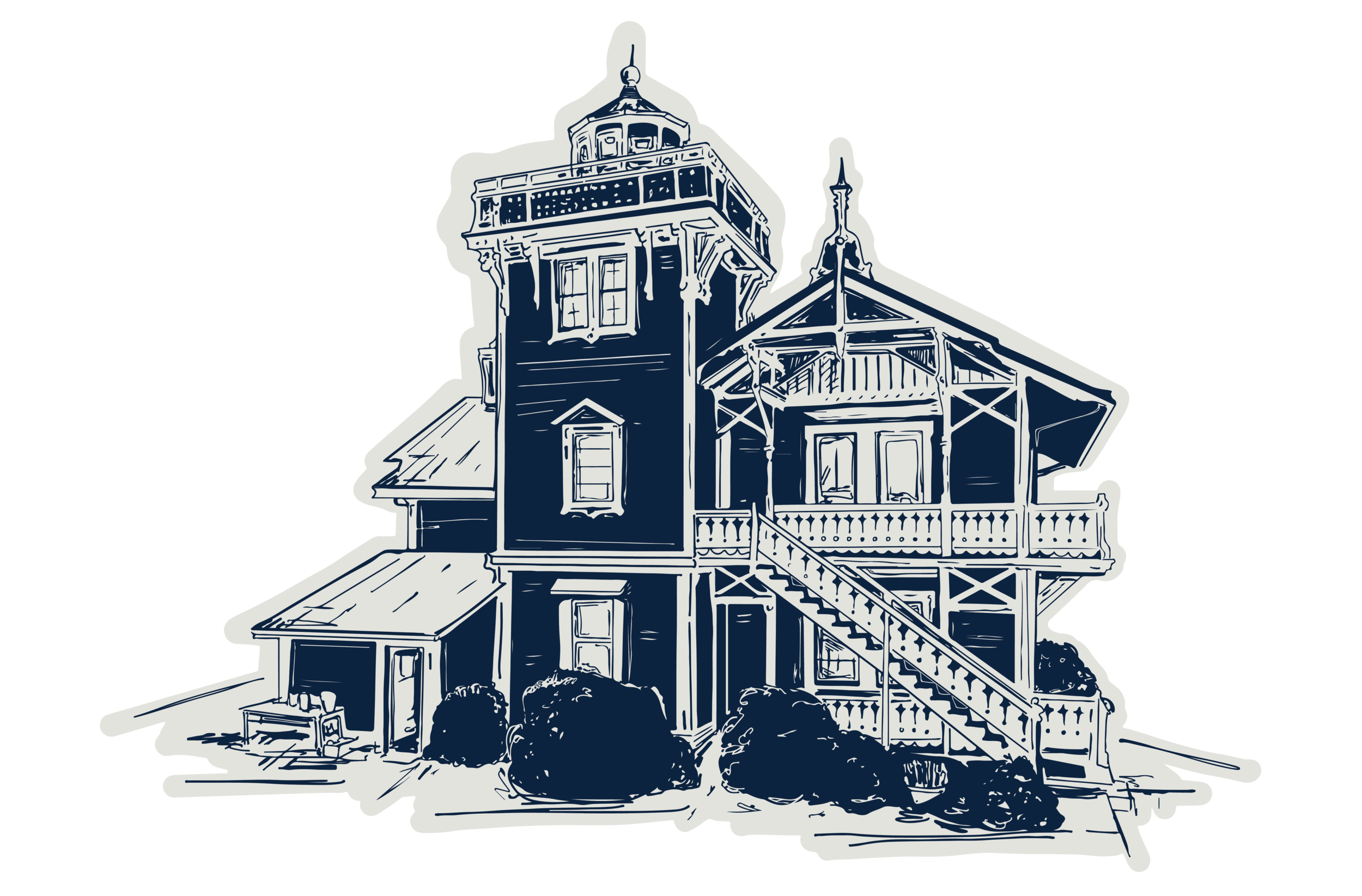On June 18, 2022, the first annual Pride and Purpose Beer Festival at East Brother Beer Company, benefiting the Rosie the Riveter Trust, will celebrate Richmond’s civic history; the people, particularly the women, who put in the work; and the drink of the laborer, Lager.
ReGrained Reimagines the Food Supply Chain
What if the grain left over from brewing wasn’t actually “spent”? That’s the question asked by Dan Kurzrock and Jordan Schwartz, co-founders of ReGrained: an upcycled food production company
Fumble-proof beers for game day
COLD IPA: NEW COLLABORATION WITH DRAKE'S BREWING CO
SUPER BOWL RECIPE: Red Lager BEER CHEESE
Beer cheese recipe:
3 tablespoons butter
3 tablespoons all-purpose flour
½ cup East Brother Red Lager (you can use Bo Pils for a lighter taste)
1 cup whole milk
1 teaspoon whole grain dijon mustard
½ teaspoons Worcestershire sauce
1 teaspoon Kinder’s Garlic Salt
½ teaspoon Kinder’s The Blend
3 cups shredded sharp cheddar cheese
Method:
1) In a saucepan, melt butter over MED heat. Add flour and whisk until combined. Cook 30 seconds, while whisking occasionally.
2) Add beer, whisking continuously as you pour, eliminating any lumps from the flour mixture. Slowly add in milk, whisking as you pour.
3) Cook over medium heat, whisking often, for several minutes, until mixture has thickened. Stir in mustard, Worcestershire sauce, Kinder's Garlic Salt and Kinder's The Blend
4) Add cheese, a handful at a time, and stir until completely melted. Serve warm!
Special thanks to Kinder’s for allowing us to borrow and adapt their original recipe.
Living Your Values With RCF Connects
RCF Connects, formerly known as the Richmond Community Foundation, was formed after an industrial accident released a cloud of sulfuric acid upon the city.
Belgian Tripel: Classic Style, Well-Crafted
Pride and Purpose: Plant to Plate
Kelli Barram and Arnon Oren Are Growing Youth at Plant to Plate
Creating an environment in which plants can flourish starts with the right soil. Similarly, a person’s attitudes, preferences, and behaviors are shaped early in life by foundational experiences, opportunities, and access. That’s why co-founders Kelli Barram and Arnon Oren created the Plant to Plate Internship Program.
“What we're doing is growing youth, their minds and skill sets, through the vehicle of a garden and a professional kitchen,” says Barram. The Richmond nonprofit selects 15 high school students each year for a 7-month paid internship and youth development program that aims to empower, train, and prepare participants not only for work in the food industry, but for life.
When it comes to matters of food, health, and conservation, advocates say the biggest gap is in education; meanwhile, kids from under-resourced backgrounds, like those Plant to Plate primarily serves, don’t have the same access to workforce opportunities and training as others. This comprehensive program teaches students the hard and soft skills necessary to grow food in the garden, prepare it in the kitchen, and serve it in a restaurant, but it also offers the tools to transform their relationship with food, finance, the job market, and even their own bodies and minds.
“It’s about problem-solving and communication skills; working as a team; managing stress; and being in community together, creating a network and an opportunity for them,” says Barram, who is also the program’ executive director and educator. Students learn gardening, kitchen basics, and both front and back of house restaurant operations—including knife skills, spices, recipe creation, and tasting—along with broadly applicable workforce training and financial management. But the program also takes a holistic approach to wellness, teaching nutrition and health as well as mindfulness and meditation. All the while, students get real, paid work experience before they’ve even received their high school diploma.
Barram met Oren, who owns and manages the restaurant and catering business Anaviv’s Table, at a fundraiser for Richmond nonprofits. At the time, Barram was the garden education specialist at Washington Elementary, and they connected over a mutual desire to expand local access to nutritious, organic food while educating and serving the community. Their partnership started with Barram supplying greens and herbs to Anaviv’s Table, but “I wanted to get involved in the community more in-depth,” says Oren, who is now Plant to Plate’s director and board president.
Barram and her colleague knew of a vacant, overgrown plot near Oren’s restaurant, and they began to envision a garden-to-table youth-development program. “There are plenty of garden and food programs for the younger kids, but not so many for high schoolers,” Oren recalls Barram saying at the time; this is especially true for those from under-resourced families, who don’t have access to other resources and enrichment programs. With the support of Oren and local nonprofit West County DIGS—which uses funding from grants and individual donations to serve school gardens in West Contra Costa—the first cohort started in January 2017, and the program is now in its fifth year.
From October through mid-April, students attend class in a raised-bed urban garden on Harbor Way; in the winter months, instruction moves to Anaviv’s Table. After establishing basic skills in a series of two-hour long evening sessions, students earn a $300 paid stipend by working 20 hours in the garden, restaurant, and/or kitchen, depending on their interests. Barram creates the curriculum, enlisting volunteer help from Richmond area professionals for certain portions, such as a recruiter who teaches resume creation and interviewing techniques.
Oren oversees the restaurant side, coordinating kitchen logistics and recruiting volunteers from his staff to help train students. “This is the most rewarding part, besides seeing the kids launching well and gaining a lot of good tools and empowerment,” he says. “Since our chefs mentor and volunteer their time to teach the kids, it empowered the employees in ways that I couldn’t imagine. Everyone throughout the [restaurant], even the dishwashers, had a connection to these kids, and it’s brought so much positivity to the business.”
While it starts with food, the skills students learn are “transferable to whatever context they're in … within the lens of what's going to be relevant to them in the next two to three years,” Barram adds, whether it’s their first job or cooking a meal in their college dorm room. Students learn everything from creative ways to use an egg to nutrition density, what makes a whole food, and navigating labels and grocery-store shopping; financial management training covers banking, the risks of credit cards, and keeping a budget.
“Within the framework of readying them, we actually give them a job. We teach them how to write a resume, and give them the experience to put on that resume,” Barram explains, “and we want to make sure we offer our interns an education about how to best manage the money they earn in our program.”
But perhaps the most impactful part is the mindfulness training, helping students cultivate a sound inner environment to manage the inevitable challenges of work and school that come their way. “We incorporate stress management psychoeducational tools, … and start every class with a moment of mindfulness,” Barram says. “They’re teenagers, so they’ll act like they hate it, … but if you ask them privately, 99% say [it’s] the one thing you cannot take away.”
Because the program is small, they can keep up with graduates, she adds, and “the most rewarding part is to see them grow up over time, to have been part of their journey, and to have hopefully played some role … in their development.”
Plant to Plate is open to applicants who are juniors or seniors in high school and live in the Richmond and San Pablo areas, recruiting from Kennedy, Richmond, and El Cerrito High Schools (priority is given to students who also qualify for assistance through the West Contra Costa Unified School District’s free and reduced lunch program). Those interested in participating, volunteering, or donating can learn more by visiting the program website or Instagram account; to apply, contact Barram through Instagram or at Plant2Plate.richmond@gmail.com.
Three beers you should be drinking on IPA DAY 2021
FOOD AND BEER PAIRING: 4th OF JULY EDITION
The two Beers you need to drink this Summer: Pre-Pro and Double IPA
After almost a year of being confined to our homes, this summer might be as close as we come as adults to replicating the bliss that was Summer Vacation. As soon as that last school bell rang, we would wander out into the world as free people, with what seemed like an endless summer full of possibilities ahead of us. Just like those good ol’ days, this summer is going to be one worth writing home about.
This summer we released TWO beers, perfect for your summer sipping. So whether you spend your summer lost in the wilderness, next to a grill, or floating down a river, our Pre-Prohibition Lager and Double IPA are the best beers to drink this summer.
East Brother Beer’s Pre-Prohibition Lager
The first of the two is a no-brainer when it comes to summer beers. Light in color, and at only 5.5% ABV, our Pre-Pro Lager will keep you cool and refreshed all day long. The Pre-Prohibition Lager, part of our Lager Series, is our take on the quintessential American Lager, the kind of Lager we were drinking long before Prohibition.
Whether you’re enjoying a classic all-American hot dog or living it up with a rib-eye steak, our Pre-Pro Lager truly shines when paired with anything that’s been grilled. So go ahead and light up the grill, and crack open our Pre-Pro, summer is just getting started.
East Brother Beer’s Double IPA
The second of our summer releases is a West Coast Style Double IPA bursting with tropical notes of papaya, mango, and pineapple. This malty Ale, part of our Freighter Series, has a slightly bitter finish with some subtle alcohol warmth.
Coming in at 8.8% ABV, our Double IPA transitions perfectly from the pool to the dinner table. This Ale can stand up to the boldest flavors, so go ahead and pair it with something smothered in BBQ Sauce or that secret sauce your Uncle always seems to have stashed in his back pocket.
Where to buy East Brother Beer?
You can find East Brother Beers at your favorite retailers, including Trader Joe’s, Whole Foods, Safeway, and Raley’s, along with hundreds of independently owned outlets. Head over to our Beer Finder to find a retailer near you if you’d rather have beer come to you, order for delivery on Drizly, GoPuff, and Instacart.
If you find yourself in the area, stop by the East Brother Taproom located at 1001 Canal Blvd, Richmond, CA, and grab a few cans of the Double IPA and Pre-Pro to-go.
Pride and Purpose: Desiree Heveroh
The first time Desiree Heveroh set foot on East Brother island, she knew she was going to live there, in the way you know things deep within your soul. What she couldn’t have predicted was how, a decade later, it would come about. The East Brother Light Station is the lovingly restored, 147-year-old Victorian lighthouse and inn that crowns the little island between the San Francisco and San Pablo Bays, and when the pandemic struck, someone had to quite literally keep the lights on. “It [felt like] fulfilling my destiny,” she says.
For the past year, Heveroh has served as the Light Station Keeper, working alongside Captain Jerrod Ward to build a unique partnership with the place and with each other. “We’re still very much in the heart of the Bay Area, and its hustle and bustle,” says Ward, who lives and works a full-time job in the city, “but when we’re here, we’re almost in this bubble. It’s like my little snowglobe.”
The Light Station is owned by the U.S. Coast Guard, but maintained by the East Brother Bed & Breakfast, the nonprofit inn that has been operating on the property since 1979. Typically, the innkeeper and a licensed Captain form a team that is responsible for maintaining the grounds and buildings. But when COVID-19 closed the inn to guests, the keepers cleared out—leaving the historic structures unattended in the face of the wind and water erosion that constantly threatens their disrepair.
In response, the nonprofit board created the volunteer keeper position; while Heveroh doesn’t discount the hardship caused by the pandemic, it also opened a once-in-a-lifetime pathway. The Visit Richmond Tourism Bureau where she had been working also closed, sending her a severance check; meanwhile, her building’s owner sold the space and bought out all the tenants. The keeper position offered lodging at the inn in exchange for handling maintenance and upkeep, and the way forward was clear. “Any minute I spend away from this gift, I can never get back, so I was happy to volunteer,” Heveroh says.
Former keeper John Barnett, who served for a record 7.5 years, recommended Ward for the Captain’s position, and on July 1, 2020, he and Heveroh moved onto the island. Ward spent the first few months training Heveroh on things like driving a boat, mechanical maintenance, and raising and lowering the hoist that is required to get boats on and off the island. What both describe as a seamless partnership was put to the test in April 2021, when the cable that provides the island’s sole source of power gave out. Not only did that mean almost no electricity, it also rendered the hoist that allows boats to enter and leave inoperable, but the community came to their rescue.
“Everyone who works on the water is aware of this place, and friends of mine who worked on tugboats, charter fishermen, and everybody in the maritime industry [was] reaching out … in order to fix it,” says Ward. When he was finally able to leave the island and return to his day job, Heveroh remained behind, “living back in time” with only a few hours of power each day provided by a Depression-era generator, but neither doubted her capabilities.
Ward visited regularly and brought supplies, and “I had a whole support group on the mainland,” Heveroh says. One of the board members “drove up to get an antique starter when the generator gave out, and talked me through how to replace it on video chat. The harbormaster had to roll it out on his boat because his engine had given out that day. Everyone on shore was making sure that I was okay.”
Besides, it was hardly the lighthouse’s first crisis. It was added to the National Register of Historic Places to save it from demolition in the late 1960s, when the Coast Guard had intended to automate the station and tear the building down. But public agencies had no funds for upkeep, and the lighthouse fell into disrepair. In response, members of the local community formed the nonprofit to restore the building and return it to public use.
Heveroh has been a board member for the past eight years and a volunteer for 10, starting as a member of the “Wicks”—the volunteer group named for the traditional wick-and-oil method once used to light the lamps—while also helping with marketing. In non-pandemic times, the Wicks spend the second Saturday of each month putting their various skills to use, from cleaning to electrical work, putting millions of dollars’ worth of work into restoring and maintaining the property.
Keeping the Light Station alive is not only important to the community, but a key part of historical preservation. “For the most part, lighthouses that are manned don’t exist anymore; they’re all automated,” Ward says. “[East Brother] is holding onto a traditional piece of history.”
It certainly inspired our brewery’s co-founders; one day while driving across the bridge, they looked left, and after seeing the island, they immediately knew what they wanted to call their business. “I appreciate a local brewery paying homage to the history of the city in their name,” Ward says. When we learned about the power crisis, we knew we had to help, so on May 5, we brought back our Freighter Series beers, donating 20% of sales to the station. Other local food and beverage businesses have joined the cause with fundraising promotions, and the station has set up a GoFundMe campaign; it’s raised over $83,000, but remains short of its $100,000 goal.
The inn expects to reopen to guests soon, but in the meantime, Heveroh and Ward have cherished the opportunity to build a uniquely intimate relationship with the place itself. “There's not going to be many people throughout history who have been out here without seeing guests,” Ward says. “For me,” says Heveroh, “it’s magical. And the world needs magic right now.”
Want to read more about Desiree and the light house? Check out the blog by our friend Dean at The Beerverse.
The GOAT is back
There’s a song that goes a little something like this: “March winds and April showers make way for sweet May flowers,” and while we think that’s cute and all, it really should be: “March Winds and April showers make way for sweet LAGERS.” That’s right, folks, we’re releasing the first lager of the 2021 seasonal Lager Series. The GOAT Lager, Maibock, is back.
East Brother Beer’s Lager Series
Those of you who are new around here, and there’s quite a few of you, might be asking, “what is the Lager Series?”. Our Seasonal Lager Series is a lineup of four unique lagers: Maibock, Pre-Pro, Festbier, and Baltic Porter. These four lagers are our way of showing the world that, despite what the Macro breweries might want us to believe, lagers are complex and full of flavor. Our Lager Series is a celebration of cold fermentation.
What is a Maibock?
Traditionally, a Maibock, also known as a Helles Bock, was brewed over the long winter and released just in time to celebrate the beginning of spring. In a way, the release of this year’s iteration of our Maibock is our way of celebrating the end of our own long, cold winter: Shelter in Place.
The Maibock is a pale, more hopped-up version of its sibling, the Bock, a dark German Ale first brewed in Einbeck, Germany. Bavarians took a liking to the Bock style, but with their charming accents, kept pronouncing the town of Einbeck as “ein Bock”, or “billy goat” which is why to this day, goats are associated with Maibocks.
Bavarians couldn’t get enough of the Bock, so much so that in the 16th century Maximillian I, "The Great" Duke of Bavaria, commissioned Elias Pilcher to brew a similar beer using Bavaria's new lagering method, creating the modern-day Maibock.
East Brother Beer’s Maibock
Some lagers are brewed for greatness, and our Maibock certainly deserves to be called the Greatest Of All Time. Last year’s Maibock was pretty darn near perfect, but if you know us at all, you know that we’re always looking for ways to make perfect even better. Employing classic German techniques for our 2021 Maibock, we turned to our friends at Admiral Maltings for their coveted Admiral Midway, a Munich Malt that gives the lager a biscuit malt flavor. This new Malt, paired with the Admiral Pils Malt we added last year, truly makes the 2021 Maibock live up to the GOAT title.
This year’s Maibock has a golden, light pale hue with a deliciously creamy white head. The aroma is slightly floral with just a hint of noble hop spiciness. Smooth, with a rich malty backbone balanced with spicy and floral noble hops. Delicate hop flavors and just enough bitterness at the end to make you want more. At 7.0% ABV, this lager is sure to wake you up.
Get this beer while it lasts. Just like any goat, this lager won’t stand still for too long and will only be around for a few weeks. Grab a pint, and a commemorative glass, at the taproom or your favorite bar or restaurant. You can find a cold can at your favorite grocery store or bottle shop.
Celebrating International Women's Day with Menbere Aklilu
A quick word on our Oatmeal Stout
We’ve always taken pride in being a no-nonsense company, and as such, we strive to be as transparent as possible. This is one of those moments. Recently, we’ve had a few reports of our Oatmeal Stout cans expanding when stored at room temperature. We took these reports seriously and immediately began a thorough investigation, discovering that a small amount of yeast was making its way into some of the cans, triggering additional fermentation as the beer warmed up and causing some cans to pop. Rest assured, yeast is a natural product, and the beer is perfectly safe to drink, but we want to make sure that every can of Oatmeal Stout out there is the best representation of our company.
We identified the issue, a batch canned back in July, and made the necessary updates to our internal processes. After rigorous testing, we are confident that the problem has been fixed. And while we believe that the chances of this happening with beer that’s been sold are very low, and even lower if the beer is kept chilled, we also believe it’s important to be proactive. Customer satisfaction is our highest priority, so we’re offering to replace any Oatmeal Stout that was canned on or prior to October 2nd. Here’s how you find out when your Oatmeal Stout was canned:
Flip your can over, each can has a printed batch number and canning date
You’ll see something like :
O STOUT 287-11 [ Style ] [Batch Number]
02-OCT-20 [ Canning Date]
If the canning date at the bottom of you your can is 02-OCT-20 or prior we’ll be happy to replace it for you. Click here to submit your exchange request.
FAQS:
Is the beer safe to drink?
Absolutely! The issue is caused by yeast, a naturally occurring and perfectly safe ingredient found in all beers.
I keep my Oatmeal Stout in the fridge, should I replace it?
If you have stored your Oatmeal Stout in the refrigerator your beer is not affected. However, we will still happily replace it if you wish.
Can I bring my beer back to the store where I purchased it for a refund or replacement?
No. Please submit a replacement request using this link and we will send you a replacement 4-pack as soon as possible.
Are any other East Brother Beer styles affected?
No. The issue is only with our Oatmeal Stout. You can store all our other beer styles wherever is most convenient for you. That said, we always encourage you to keep your beer chilled in order to preserve freshness and flavor.
Travel The Globe with East Brother's Russian Imperial Stout
This season, we’re thrilled to release the latest in East Brother’s Freighter Series: the Russian Imperial Stout.
Come take a trip with us.
It’s no coincidence that we produce Russian Imperial Stout (RIS) during the same season as our Baltic Porter. Like its predecessor, RIS has its roots in English brewing traditions, and a visit to England by Peter the Great brought these beers to the attention of Eastern Europe.
At the time the term “Stout” only referred to the strength of the beer and not its distinctive color, but Peter’s visit solidified this style’s association with Russia for centuries to come. Initially, the beer was brewed solely by Thale’s Anchor Brewery and then shipped to Russia. Eventually, the style became a staple in American brewing, and the term “imperial” almost always refers to a higher strength version of a style.
Likewise, our RIS is our heaviest hitter yet at 10.5%, just in time for cozy nights indoors and sweater weather. As the days slip into night earlier and earlier (meaning that drop from 60 to 40 degrees is happening sooner) this is the perfect beer to grab—and its hue matches the midnight sky to boot.
This year’s RIS might be our best yet. We partnered with our favorite local maltsters, Admiral Maltings, to design a malt profile that balances both the sweetness and bitterness of this classic style. The resulting flavor is both smooth and nuanced. Find notes of chocolate, a sherry aroma, cocoa nibs, and dark fruits. It’s like drinking a mocha from your favorite coffee shop.
Although we can’t travel now, a sip of this beer is a reminder of all the lives a classic beer style lives. This beer has traveled around the world to be with you, in your hands, and the deep history and tradition of RIS reminds us of why we love classic styles—there’s hundreds of stories, years of tales that unravel with every sip.
You can pick up our Russian Imperial Stout in our taproom, order to-go or for local delivery, or we’ll ship to you anywhere in California. Come explore with us.
Baltic Porter is the Working Person's Drink!
Sometimes a phrase, like our slogan—Beer is Labor—can feel like just words on a page. Everyday at East Brother, we think about the words we choose to describe our business, ourselves. We choose to make classic beers meticulously and with precision, and our Baltic Porter is the perfect expression of Beer is Labor.
Porters were the preferred drink of street and river porters working in the streets of Britain in the 18th century, hence the name of this style. It’s a riff on Brown Ale that’s heavily hopped, aged for six months, and deep brown in color with a high ABV. As this style of beer became more and more popular, Porters were exported across the globe. Soon, Porters became one of the first beer styles to extend beyond its regionality and consumed worldwide.
However, that’d quickly change. It was common for local brewers in countries across Eastern Europe to adapt Porter recipes based on the ingredients they had on hand and local preferences. But this took off in 1806, when Napoleon, then King of the French, implemented a Continental Blockade that cut off imports from Britain into the Baltic countries. That meant that folks who wanted to drink Porters had to make the beer themselves.
Local production of Porters took off in the Baltic region—we’re talking about countries that border the Baltic sea like Poland and Finland. Eventually, the beer developed into its own distinct style, which is what we honor in our Baltic Porter. These beers thrive in colder climates, and substitute common British ingredients and techniques, like lager yeast and continental hops. Traditionally, this beer is cold-fermented and cold-lagered, which helps preserve its clean and complex flavors.
Baltic Porters fell out of fashion during the 1900’s, particularly during the Cold War, but this classic style resurged in popularity over the last twenty years. Their production is truly a demonstration of labor and adaptability, and offers a warming accompaniment for hearty foods like grilled meats, heavy stews, and indulgent desserts. Basically, this is the perfect beer to stick to your bones after a hard day’s work.
There’s a reason this beer was beloved by porters in the 18th century—folks who worked hard for their supper and thirsted for something deeply satisfying after a long day’s work. That feeling, that need for something comforting and warming, feels especially necessary now. In the last few months, so many of us have upended our lives, found new systems to make our homes and families function in an unprecedented moment in history. It’s never been a better time to release a beer that celebrates hard work, that feels like a bridge between a job well done and a moment to rest.
We release a Baltic Porter every year around this time. This year’s Porter, which will be available in cans on November 17th, clocks in at 8.6% ABV made with Halycon Malt as the base, and Crystal, Chocolate, and Black malts that add flavor and complexity. It’s made with a German Lager yeast and boasts flavors of dark fruits, like plums and cherries, chocolate, and molasses. It’s both refreshing and comforting—each sip of our Baltic Porter is satiating yet inviting. You’ll keep coming back for this treat.
Pride & Purpose: Richmond Promise
The city of Richmond knows itself. We’ve seen it all before — great booms, big busts, the ebb and flow of a diverse community — and learned from our experiences. The only way forward these days is to move with intention in this ever-shrinking world. At East Brother Beer, we take pride in our great city and its storied history and go forward with purpose towards a bright future.
East Brother Pre-Pro Lager — A Century In The Making
Prohibition radically altered the way beer was brewed and consumed, so trying to replicate beers brewed before Prohibition could come off as a daunting task—but one we were eager to take on. Because of Prohibition, many small-scale breweries shuttered or were absorbed by large-scale breweries. With fewer and fewer breweries, beer became more uniform in style. Light Lagers became the norm in America, even after Prohibition.
East Brother Double IPA—A Beer for Dads and the Folks Who Love 'Em!
This year’s DIPA is a celebration of both classic and local. We worked with Admiral Maltings, based in Alameda, to source the malt for this beer. We added Simcoe and Azaaca hops to bring out the classic flavors you’d expect from a DIPA—the combination of the two hops brings forth intense citrus flavors and mango notes. You’ll feel like summer is shining right on you.





